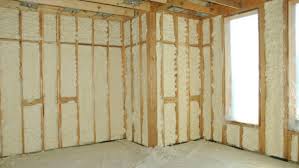Spray Foam Insulation
Closed Cell Spray Foam Insulation

t
When Tonya and Stephen’s old tar-and-gravel roofing started dripping, the couple intended to discover a replacement roof that would be energy-conserving, leakproof, cost-competitive, as well as reasonably eco-friendly. As your house’s roofing system doubles as a finished ceiling, the old insulation was scant. They broiled in the summertime as well as wasted money throughout the home heating period. Eventually, they picked to set up a closed-cell splashed polyurethane foam (SPF) roofing system– sprayed straight over the old tar-and-gravel roofing system– because:
The revealed bottom of the 2 × 6 T&G roofing system deck was traditional. The ceilings were simply a shade above 8 ft. and also the pair really did not want to shed 4 in.Closed-cell SPF has an R-value of 6.5 per inch, making it the best remedy to the old roofing system’s dismal energy profile. The old roof setting up, with 2 layers of 1/2-in. fiber board, attained (perhaps) R-3 or R-4. Four inches of SPF would certainly bring it up to a minimum of R-26; six inches would bring it to R-39. Spray foam was also specifically well matched to this roofing since it had parapets, which defined the edges of foam. (Exterior spray foam only deals with low-pitch or level roofing; for pitches above 4/12, rigid foam panels are the over-roof-deck option.).
A spray-foam roof system could be applied straight to the old roof once it was prepped as well as cleaned up a little bit. Not removing the old roofing and sending out the debris to the land fill was also a big eco-friendly plus. Besides, spraying-over would certainly save the labor prices of removing the old roofing.
Four inches of closed-cell polyurethane is a Class II water retarder, a semi-impermeable membrane that makes leaks just about difficult. As the foam increases and adheres, it would certainly secure the many pipelines as well as avenues running across the roof of a residence without any cavities under the sheathing in which to hide pipelines.
Compared to the apparent choices, an SPF roofing system was in fact more economical than mounting and then protecting either a new torch-down roofing system or a PVC membrane layer. Which didn’t also include the expense of removing the old roof. There were energy-efficiency refunds offered for setting up an SPF roofing system but the couple was so busy that, as Stephen placed it, “We could not manage the time to conserve money.”.
Is spray foam roof covering environment-friendly?
Was this spray polyurethane foam an environment-friendly choice? Because the early days of sprayed foam insulation (the earliest foams were urea-formaldehyde based), the insulation industry has actually cleaned up its act a lot.
An SPF roofing can likewise be quite resilient when the polyurethane is splashed with an unique acrylic top finishing that secures the foam versus UV deterioration. The foam’s light color will reflect sunlight so, all in all, it must be a loved one amazing roof covering.
Spray foam was likewise particularly well matched to this roof because it had parapets, which defined the sides of foam. (Exterior spray foam just works on level or low-pitch roofing systems; for pitches better than 4/12, inflexible foam panels are the over-roof-deck choice.).
Compared to the noticeable options, an SPF roofing was actually much less pricey than setting up and then insulating either a new torch-down roofing system or a PVC membrane. An SPF roof can also be rather resilient when the polyurethane is splashed with a special acrylic top coating that shields the foam versus UV destruction. The foam’s light color will certainly show sunlight so, all in all, it should be a family member awesome roofing system.
